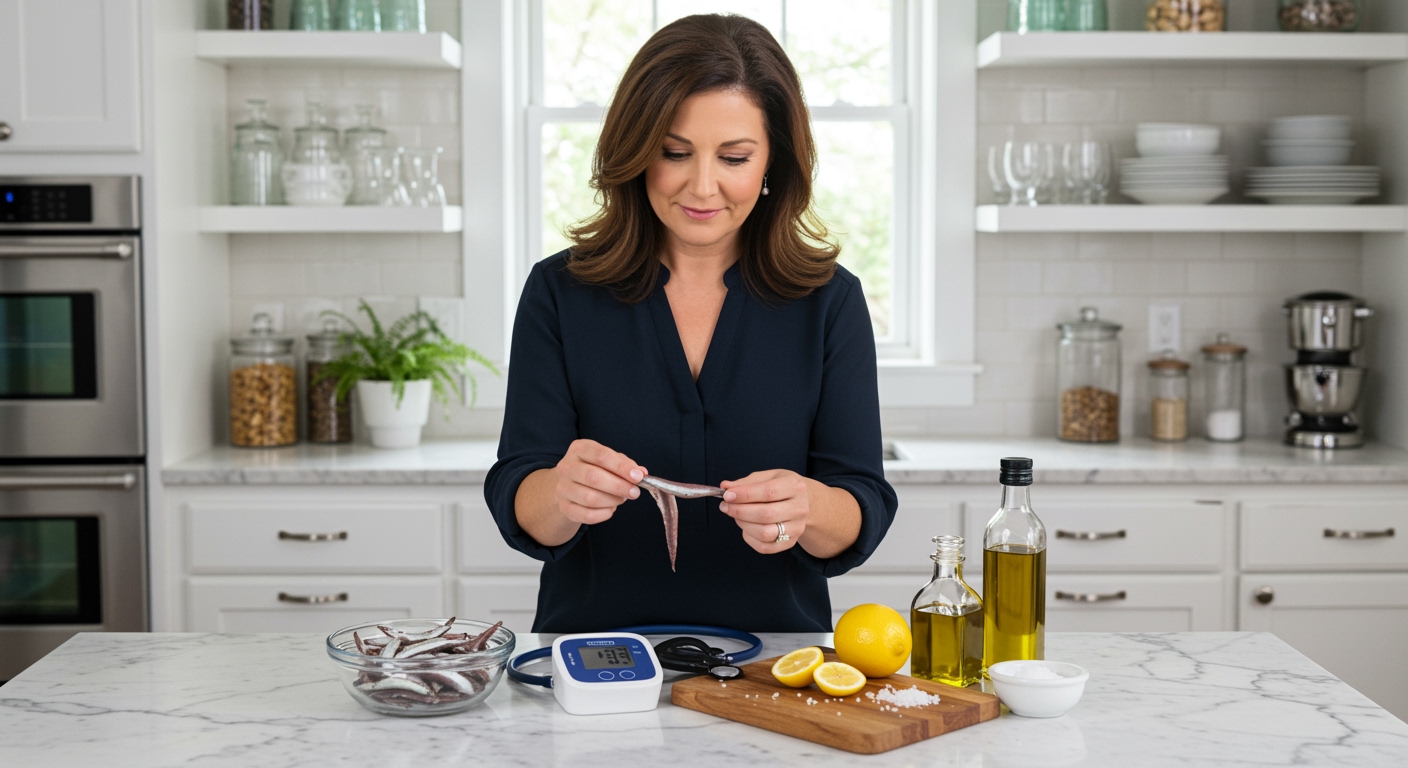✪ Key Takeaway: Sardines can help raise low blood pressure naturally through their sodium content and blood-supporting nutrients.
Introduction
Your doctor just told you that your blood pressure is dangerously low, and you are searching for natural ways to bring it back to healthy levels.
You might be wondering if sardines, those tiny canned fish, could actually help raise your blood pressure instead of lowering it like most heart-healthy foods do.
Hi, I am Abdur, your nutrition coach, and today I am going to explain exactly how sardines can naturally help people with low blood pressure and when this approach makes sense for your health.
How Do Sardines Affect Blood Pressure Levels?
Sardines contain significant amounts of sodium, which directly impacts blood pressure by increasing blood volume and helping your heart pump more effectively.
A typical serving of canned sardines provides about 400-500 milligrams of sodium, which represents roughly 20% of the daily recommended intake for most adults.
This sodium content works by causing your kidneys to retain more water, which increases the total volume of blood circulating through your blood vessels.
When blood volume increases, your heart has more fluid to pump, which naturally raises the pressure against your artery walls.
The omega-3 fatty acids in sardines also support healthy blood vessel function, ensuring that your circulatory system can respond appropriately to changes in blood volume.
Additionally, sardines provide vitamin B12 and iron, which are essential for healthy red blood cell production and oxygen transport throughout your body.
✪ Fact: One can of sardines contains more sodium than a slice of pizza, making it surprisingly effective for low blood pressure.
What Makes Sardines Different From Other Fish?
Unlike fresh fish, canned sardines are typically preserved in salt water or brine, which significantly increases their sodium content compared to other seafood options.
Fresh salmon or tuna contains only about 50-100 milligrams of sodium per serving, while sardines can contain four to five times that amount.
The canning process also concentrates the nutrients in sardines, making them a more potent source of blood-supporting vitamins and minerals.
Sardines are small fish that are eaten whole, including their bones, which provides additional calcium and phosphorus for cardiovascular health.
The combination of sodium, healthy fats, and bone-building minerals makes sardines uniquely suited for people who need to raise their blood pressure naturally.
Most other fish are recommended for lowering blood pressure, but sardines work in the opposite direction due to their processing method and natural composition.
✪ Pro Tip: Choose sardines packed in water rather than oil to maximize the sodium benefit without excess calories.
When Should You Use Sardines For Low Blood Pressure?
Sardines work best for people with hypotension (blood pressure below 90/60 mmHg) who experience symptoms like dizziness, fatigue, or fainting spells.
If your low blood pressure is caused by dehydration, blood loss, or certain medications, the sodium in sardines can provide quick relief by restoring blood volume.
People with postural hypotension, where blood pressure drops when standing up, often benefit from the sustained sodium release that sardines provide.
However, you should avoid sardines if your low blood pressure is related to heart failure, kidney disease, or if you are taking blood pressure medications without medical supervision.
The timing of sardine consumption matters too – eating them earlier in the day allows your body to process the sodium and adjust blood pressure gradually.
Always monitor your blood pressure response and consult with a healthcare provider before using sardines as a therapeutic food for hypotension management.
✪ Note: Track your blood pressure for one week before and after adding sardines to see if they help your specific condition.
How Much And How Often Should You Eat Sardines?
For low blood pressure management, eating half a can of sardines (about 2-3 ounces) three to four times per week provides optimal sodium intake without overdoing it.
This amount delivers approximately 200-250 milligrams of sodium per serving, which is enough to support blood pressure without causing excessive sodium intake.
You can eat sardines on whole grain crackers, mixed into salads, or straight from the can depending on your taste preferences and dietary needs.
Combining sardines with other blood pressure supporting foods like beetroot juice, leafy greens, and adequate water intake creates a more comprehensive approach.
Avoid eating sardines daily, as this could lead to excessive sodium intake and potentially cause your blood pressure to swing too high in the opposite direction.
Monitor your body’s response and adjust the frequency based on how your blood pressure readings change over time with consistent measurement.
✪ Pro Tip: Pair sardines with potassium-rich foods like bananas to help your body balance sodium levels naturally.
The Bottom Line
Sardines can indeed help raise low blood pressure naturally through their sodium content and blood-supporting nutrients, making them a practical food choice for people with hypotension.
The best nutrition strategy is always the one that works with your body, not against it, and sardines offer a simple way to support healthy blood pressure when levels are too low.
I would love to hear about your experience with sardines or any questions you have about managing low blood pressure naturally – please share your thoughts in the comments below.
References
At NutritionCrown, we use quality and credible sources to ensure our content is accurate and trustworthy. Below are the sources referenced in creating this article:
- Healthline: How to Raise Blood Pressure
- WebMD: Health Benefits of Sardines
- Medanta: Natural Remedies to Fix Low Blood Pressure at Home
- Healthgrades: Natural Ways to Raise Low Blood Pressure





